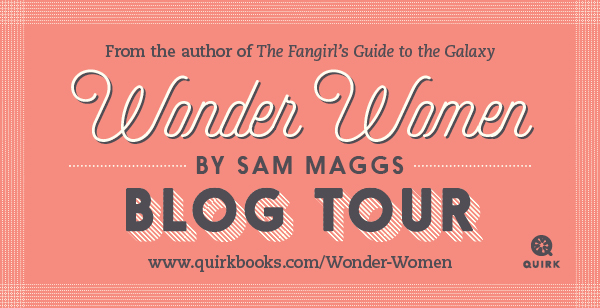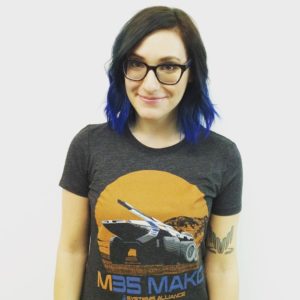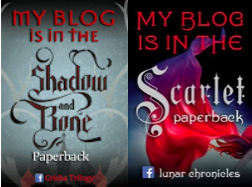I’m thrilled to be wrapping up the blog tour for Wonder Women by Sam Maggs. When I first heard about this book I knew it was something I wanted to check out. And, you guys, it’s so cool! Here’s more about it:

Ever heard of Allied spy Noor Inayat Khan, a Muslim woman whom the Nazis considered “highly dangerous”? Or German painter and entomologist Maria Sibylla Merian, who planned and embarked on the world’s first scientific expedition? How about Huang Daopo, the inventor who fled an abusive child marriage only to revolutionize textile production in China?
Women have always been able to change the world, even when they didn’t get the credit. In Wonder Women, author Sam Maggs introduces you to pioneering female scientists, engineers, mathematicians, adventurers, and inventors—each profile a study in passion, smarts, and stickto-itiveness, complete with portraits by Google doodler Sophia Foster-Dimino, an extensive
bibliography, and a guide to present-day women-centric STEM organizations.
For today’s tour stop I have an exclusive bonus interview between Wonder Women author Sam Maggs and Grace C. Young, scientist, ocean engineer, and aquanaut.
Interview:
Sam Maggs: When did you first realize you were interested in pursuing science as a career? Were you encouraged by your family, school, and/or community?
Grace Young: It was really a combination of influences. Math and science were always my favorite subjects in school. That may be how my brain is wired – my mom and uncle are similar. But I also grew-up in an innovative environment. My family ran a chocolate factory that my great-grandfather founded, so from a young age I was surrounded by robotic machines that stirred, poured, molded and wrapped chocolates.
My first interaction with an autonomous robot was with a Roomba vacuum cleaner. I think I was in 6th or 7th grade. I was just as fascinated as I was with the machines in the chocolate factory.
When a volunteer STEM mentor started a robotics team at my high school, I joined, although I had no idea what I was getting into. And it clicked! Everyone on the team really encouraged each other.
At the time, I was also seriously into ballet, training about 20 hours per week in addition to performances. As robotics began cutting into my dance schedule, I had to begin making time-management choices. The company I danced with, CityDance in Washington, DC, was very supportive, and encouraged me to pursue both interests simultaneously. It was hard when I had to miss some rehearsals for robotics tournaments and vise-versa, but other dancers helped me catch-up on steps and it all worked-out in the end. The director of the company recognized each of us as a whole person, not just as a dancer in the studio. Although I gave up any notion of a professional ballet career, the discipline and endurance that ballet training imbued in me has helped me immeasurably in my STEM career.
Maggs: What were some difficulties or barriers to entry you experienced while getting into your field, and how did you overcome them?
Young: When I joined my high school robotics team, I was the only girl and started a month or two late. The boys were all life-long “gamers” and had already been working on their robots and coding for weeks before I joined. I felt way behind and, frankly, out of place. I could’ve resigned myself to an inconsequential role because they were already better at programming and too far ahead of me, but I really wanted to learn the entire process. So I recruited another girl and together we designed, built, and programmed our own robot in an incredibly intense three weeks before our first tournament. Immediately afterward, we tore it apart and started all over again to make it better before the next tournament. We did, ultimately qualifying for National and World Championship tournaments. It was a tremendous learning experience.
Another major challenge or hurdle was my first semester at MIT. I’d dropped out of high school and went straight to MIT after my junior year. I remember heading into my physics mid-term exam feeling ok about it. Then I got my results and it was a wake-up call. At our opening convocation, MIT’s president told us that their mission was to “push us beyond our comfort zone.” Right then and there I understood what she meant. I realized I needed to step-up my game and come up with a whole new way to study.
A lot of people assume that because I’m a woman I face particular challenges, but that’s not been my experience. I’m often asked “Isn’t it hard being a female engineer?” Or before a deep diving expedition “Aren’t you scared?” These are questions men aren’t generally asked. Although women make up only 11% of engineers, I’ve never faced any challenges unique to women in STEM fields, and as far as risks, I’ve never thought twice about taking the same risks as my male colleagues. While these questions may be the result of latent concerns about women in underrepresented professions, I’ve found the STEM community is generally quite progressive and indifferent to gender.
Maggs: Tell us a little about your current work in mechanical and ocean engineering.
Young: Right now I’m working on my PhD at Oxford University as a member of its Ocean Research and Conservation Group. I’m researching how the 3D structure of coral reefs influences the health of the ecosystems that depend on them. Most people don’t realize that coral reefs are fundamental to marine life, and without marine life, humans cannot survive. 25% of all ocean species is entirely dependent on coral reefs; yet these reefs are rapidly disappearing due to pollution, acidification, overfishing, and effects of climate change. It’s estimated that at least 10% of the oceans’ coral reefs are already completely destroyed, but as much as 2/3rds are seriously damaged. We’re finding that as coral reefs are degraded, the loss of that structural complexity directly affects the health of the marine life around the reef. While we need to fix the root causes of reef destruction, we also need to know how to remediate degraded reefs or construct artificial reefs to preserve marine life. I’m trying to figure out the specific 3D structures that support the healthiest ecosystems at different depths and in different marine environments.
What I really enjoy about my research, aside from a lot of diving, is that it’s truly interdisciplinary, involving engineering and ecology.
Maggs: You’re also passionate about the arts, having won and recently constructing the Ocean Pavilion sculpture in Vienna. How have you found science and the arts compliment each other in your career?
Young: Science and the arts are not only complementary, but integral to each other. Great scientific breakthroughs are achieved through a creative process. Creativity is just as necessary for great science as it is for great art. Is it surprising that Leonardo was simultaneously one of the greatest artists and inventors in Western civilization? Or that Einstein and Max Planck were world-class violinists? Einstein said he thought in music; he daydreamed in music; he even saw his life in terms of music. Where would science be today without the arts? I’m not sure why modern culture tends to separate the two. That distinction, I think, is a historical anomaly. Look at the greatest human achievements from Chinese, Greek, Islamic, and European civilizations. It’s hard to distinguish art from science.
Science often infuses great art, but the creative mind so typical of artists is what produces great science. There’s a trend in science now to push for practical applications of study in applying for research grants. While on the one hand, that’s perfectly understandable, on the other, it tends to stifle great science. You can’t always anticipate applications of study. Sometimes you just pursue a line of study purely for the sake of knowledge, because you’re curious. CERN didn’t foresee the applications of the World Wide Web when it was developed for particle physicists, nor did NASA foresee the applications used by virtually every human almost every minute of the day when it funded the Apollo program. I think the arts community has a better grasp of this concept – you can appreciate art just because it’s art. It doesn’t have to go anywhere or need a practical rational; yet the results can be spectacular.
Maggs: You basically make wicked-cool underwater robots for organizations like the Woods Hole Oceanographic Institution and the NOAA. In your opinion, what is the most exciting robot you’ve ever built (or alternately, the most exciting thing one of your robots has ever done?)
Young: I’ve been fortunate to have had some fantastic robotics mentors and work in really great labs, especially Dr. Hanu Singh and his lab at Woods Hole. His WHOI lab designs and builds some phenomenal aerial and submersible AUV/ROVs that have made a big impact on ocean research. My most memorable robot, however, is probably the fairly simple submersible ROV I helped design and build for NOAA during a summer internship in Hawaii. The ROV could monitor the health and populations of fisheries in our Pacific marine sanctuaries to better help NOAA decide annual fishing quotas.
Maggs: What advice would you give young women who want to get into STEM?
Young: Don’t be discouraged by your age, your gender, or your lack of experience. Take advantage of every available opportunity to get involved with a specific project related to a potential field of interest. Go outside your comfort zone. Finally, seek out mentors.
Grace Calvert Young is an MIT graduate in Mechanical & Ocean Engineering dedicated to developing technology to explore and manage sustainably our oceans’ resources while conserving their fragile ecosystems. Currently a Marshall Scholar and PhD candidate at Oxford University, Grace has done everything from developing software for CERN and MIT to working to design, build, and test submersible and aerial robots for Woods Hole Oceanographic Institution and NOAA to helping construct the “Ocean Pavillion” sculpture commissioned by the Thyssen-Bornemisza Art Contemporary in Vienna. An avid sailor and scuba diver, Grace is a four-year letterman on MIT’s sailing team and has received of numerous academic awards, including the Wallace Prize as MIT’s top ocean engineering undergraduate and Keil Award for excellence in ocean engineering research. Find her online at graceunderthesea.com or follow her on Twitter @grace_h2o.
About the Author:
SAM MAGGS is an Assistant Writer for BioWare, and the bestselling author of The Fangirl’s Guide to the Galaxy and the upcoming Wonder Women, both published by Quirk Books and distributed by Penguin Random House.
Tour Schedule:
Bibliophile Gathering on 10/3
A Foodie Bibliophile in Wanderlust on 10/4
We Are Word Nerds on 10/5
Pop! Goes the Reader on 10/6
YA Bibliophile on 10/7














Rachana
Wow this book sounds incredible haha. I also found the interview very interesting as an upperclassmen in high school thinking of going to a liberal arts college. I’ve always considered my lack of experience as a good reason for not pursuing STEM-related things but Young’s answer to the last question reminded me that I need to take risks more if I really am interested in something.